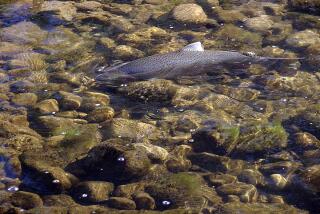Endangered protections
According to the bush administration, a human-built dam is as much a part of the natural ecosystem as, say, a canyon. No one needs to mess with dams that impede endangered wild salmon, according to administration reasoning, because the fish are doing fine -- you can tell by looking at how many of them are produced in human-operated fisheries.
Fortunately, a judge put an end to this nonsense involving the salmon of the Snake and Columbia rivers after environmentalists and fishermen sued, contending correctly that the federal plan to protect the fish fell short. Another lawsuit successfully challenged off-roading and livestock operations in areas where the desert tortoise lives.
So when property-rights advocates say the Endangered Species Act produces a lot of litigation, they’re right. When law is undermined by the government, and negotiations and complaints fail, the only recourse is to sue.
Those lawsuits would have less chance of prevailing under draft legislation being circulated by Rep. Richard W. Pombo (R-Tracy) that would weaken the act and appease drilling, timber, fishing and development interests. It would make adding species to the list more difficult, narrow the definitions for invasive species and hamper agencies with new paperwork.
Its most troubling provision, though, would free the government from the requirement to restore rare species to self-sustaining populations. Simply heading off extinction would suffice. Condors might arguably be considered protected if they existed only in zoos. But less intervention by government actually means more baby-sitting of species. Hardly any plant or animal populations would grow enough to be delisted -- the point at which the government no longer needs to intervene on their behalf.
With 5,000 or so pairs of bald eagles nesting in the Lower 48 states, robust populations of California gray whales migrating predictably along our shore and peregrine falcons nesting on New York skyscrapers, it can be too easy to forget how poor and empty our world might have been without the Endangered Species Act. Of the 1,200 or so domestic species under the 32-year-old law’s protection, only nine have become extinct. Compare that with the 83 that went extinct while waiting to be listed, or the thousands estimated to disappear worldwide each year.
The act could be made less onerous, without making it less effective, by cutting red tape and providing reasonable incentives for landowners and industries to protect species. This doesn’t always have to mean new money; the group Environmental Defense points out that the federal government already subsidizes farmers who plant fallow fields with grasses as a guard against soil erosion. Planted with native vegetation, those fields could become habitats for birds, bugs and other creatures.
Preserving the key protections of the Endangered Species Act is about more than keeping awe-inspiring raptors and grizzlies around. It has restored environmental balance in areas that had lost their natural predators.
An obscure lizard could contain antibodies to protect against a killer disease; the extinction of a plant might set off the loss of other species -- or conversely, allow other, peskier species to thrive unchallenged. Humans need this act as much as plants and animals do.
More to Read
Sign up for Essential California
The most important California stories and recommendations in your inbox every morning.
You may occasionally receive promotional content from the Los Angeles Times.










